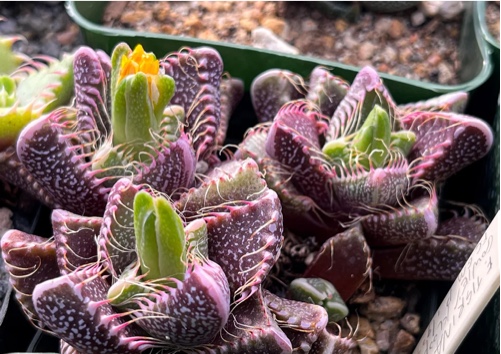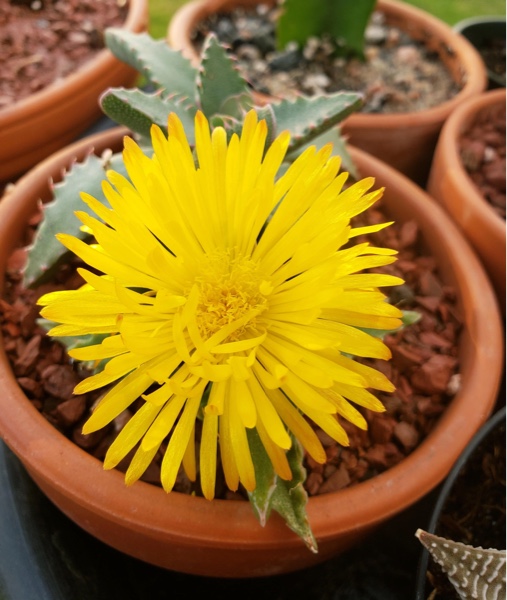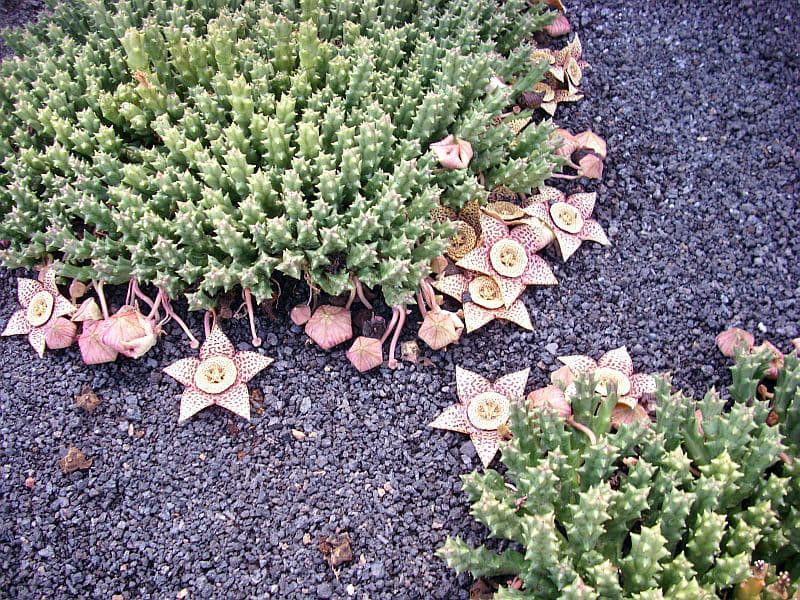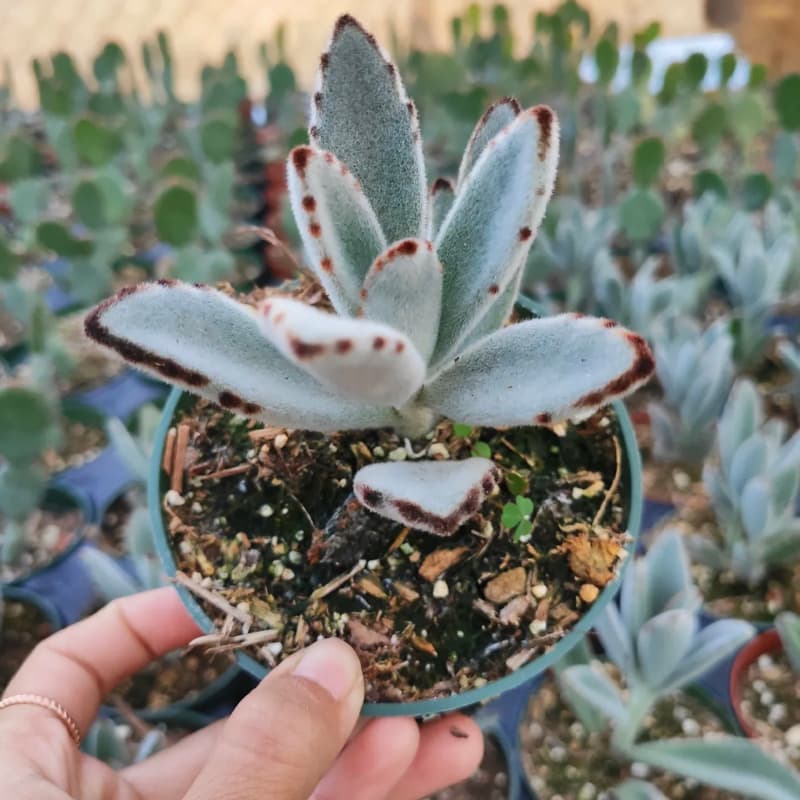Faucaria Tigrina "Tiger's Jaw"
Posted by Grace on September 10, 2023
Quick Facts
- Native Habitat: South Africa
- Family: Aizoaceae
- Water: Moderate
- Sunlight: Full sun to partial shade
- Soil: Well-draining succulent mix
 Faucaria Tigrina In South Africa
Faucaria Tigrina In South Africa
Contents
Why it is called Faucaria tigrina and Tiger's Jaw?
The name "Faucaria tigrina" and the common name "Tiger's Jaw" are both inspired by the plant's unique appearance:
Faucaria tigrina
Genus (Faucaria): The genus name "Faucaria" is derived from the Latin word "faux," meaning "jaws" or "mouth." This name is a reference to the appearance of the leaves, which have rows of tiny, white teeth-like structures along their edges, resembling the jaws or teeth of an animal.
Species (tigrina): The species name "tigrina" comes from the Latin word "tigrinus," meaning "tiger-like" or "resembling a tiger." This name is given because the dark, reddish-brown spots or markings on the green leaves of Faucaria tigrina resemble the stripes or patterns found on a tiger's coat.
Tiger's Jaw
The common name "Tiger's Jaw" is a direct reference to the unique appearance of the plant's leaves. The triangular, fleshy leaves are covered in rows of tiny, white, tooth-like structures, giving them the appearance of a tiger's jaw or teeth. This name vividly describes the visual characteristics of the plant.
In summary, both the scientific and common names of Faucaria tigrina are inspired by the distinctive shape and markings of its leaves, which resemble the jaws and teeth of a tiger.
The Appearance of Faucaria tigrina
Faucaria tigrina, also known as Tiger's Jaw, is a distinctive succulent known for its unique and intriguing appearance.
Leaves
- Shape: The leaves of Faucaria tigrina are triangular and fleshy, arranged in a rosette formation. They have a succulent texture and are typically green in color.
- Markings: One of the most striking features of Tiger's Jaw is the presence of dark, reddish-brown spots or markings on the surface of its leaves. These markings are arranged in a pattern that resembles the stripes or spots found on a tiger's coat, hence the common name "Tiger's Jaw."
- Tooth-Like Structures: Along the edges of the leaves, there are rows of tiny, white, tooth-like structures. These structures give the leaves a unique and toothy appearance, further contributing to the plant's name.
- Size: The leaves of Faucaria tigrina can grow to be about 3-4 inches (7-10 cm) in length.
 Faucaria Tigrina ex Gowies Kloof at the Sphaeroid Institute (Source)
Faucaria Tigrina ex Gowies Kloof at the Sphaeroid Institute (Source)
Flowers
 Faucaria Tigrina Blooming
Faucaria Tigrina Blooming
- Color: When in bloom, Tiger's Jaw produces small, daisy-like flowers. These flowers are typically yellow and add a delightful splash of color to the plant.
- Appearance: The flowers have a charming, star-like appearance with multiple petals radiating from a central disk. They can appear singly or in clusters.
- Stem: The flower stems emerge from the center of the rosette of leaves and can extend above the foliage.
- Blooming Period: Faucaria tigrina tends to bloom during the growing season, which is typically in spring and sometimes into early summer.
- Attractiveness: While the main attraction of this succulent is its unique leaves, the flowers provide an added aesthetic appeal.
The combination of its distinctive triangular leaves with tiger-like markings and charming yellow flowers makes Faucaria tigrina a captivating addition to any succulent collection.
How to Care for Faucaria tigrina
Light
Tiger's Jaw thrives in bright, indirect sunlight or partial shade. In its natural habitat, it often experiences intense sun with well-draining soil. Ensure it receives at least 6 hours of sunlight daily for optimal growth.
Watering
Water sparingly, allowing the soil to dry out completely between waterings. Overwatering can lead to root rot, so it's crucial to err on the side of underwatering.
Soil
Use a well-draining succulent mix to plant your Tiger's Jaw. A mix of cactus soil and perlite or sand works well to ensure proper drainage.
Temperature
Tiger's Jaw prefers temperatures between 70-80°F (21-27°C) during the growing season. Protect it from frost and cold temperatures, as it is not cold-hardy.
Humidity
This succulent is adaptable to average household humidity levels, making it suitable for most indoor environments.
Fertilizing
Fertilize sparingly during the growing season (spring and summer) with a diluted, balanced liquid fertilizer. Avoid fertilizing during the dormant winter months.
Pruning
Minimal pruning is required. Remove any dead or dried-up leaves to maintain the plant's appearance.
Repotting
Repot when the plant outgrows its container or when the soil becomes compacted. Spring is the best time for repotting.
Dormancy
Tiger's Jaw enters a dormancy period during the winter. During this time, reduce watering significantly and keep the plant in a cooler location (50-60°F or 10-15°C).
Pests and Diseases
Tiger's Jaw is generally resistant to pests and diseases. However, watch out for mealybugs and aphids, which can occasionally infest these plants. Treat infestations promptly with neem oil or insecticidal soap.
Need tools for succulent propagation and repotting? Here are my go-to tools: mini tool set (including syringe 💉, gloves 🧤, tweezers 🪤, dust blower 💨, tiny shovels 🛠️) and well-draining mix 🌱.Is Faucaria tigrina Toxic to Pets?
Tiger's Jaw is considered non-toxic to pets, making it a safe choice for households with cats or dogs.
How to Propagate Faucaria tigrina
 Faucaria Tigrina (Source)
Faucaria Tigrina (Source)
Propagation by Offsets (Pups)
-
Identify Offsets: Look for small offsets or pups that have grown at the base of the parent plant. These are essentially baby plants that can be separated and grown into new individual plants.
-
Prepare a New Container: Get a small pot or container with well-draining succulent soil. Make sure the pot has drainage holes to prevent overwatering.
-
Separate the Offset: Gently remove the offset from the parent plant. You may need to use a small, clean knife or scissors to carefully cut it away if it's firmly attached. Ensure you don't damage the roots.
-
Let It Callus: Allow the cut end of the offset to air dry for a day or two. This step helps to prevent rot when you plant it.
-
Plant the Offset: Once the cut end has calloused, plant the offset in the new container. Make a small hole in the soil with your finger or a stick and place the offset in it. Press the soil gently around the offset to hold it in place.
-
Water Sparingly: Water the newly planted offset lightly. After planting, refrain from watering for a few days or until you notice new growth or roots developing.
-
Provide Adequate Light: Place the container in a location with bright, indirect sunlight. Avoid direct sunlight until the new plant is established.
-
Monitor Growth: Over time, the offset will grow and establish its roots. You can treat it like a mature Faucaria tigrina once it shows signs of growth.
Propagation by Seeds
-
Collect Seeds: If your Tiger's Jaw succulent produces seeds, collect them from the mature plant's seed pods or flowers.
-
Prepare a Seed Tray: Fill a seed tray or a shallow container with a well-draining succulent potting mix. Ensure the tray has drainage holes.
-
Sow the Seeds: Sprinkle the collected seeds evenly over the soil surface. Don't bury them too deep; a light press into the soil will suffice.
-
Mist the Soil: Use a spray bottle to mist the soil lightly to settle the seeds in place.
-
Cover and Enclose: Place a clear plastic lid or plastic wrap over the seed tray to create a mini-greenhouse effect. This helps maintain humidity.
-
Provide Indirect Light: Place the seed tray in a location with bright, indirect sunlight. Avoid direct sun, as it can overheat the tray.
-
Maintain Moisture: Keep the soil evenly moist but not waterlogged. Ensure good ventilation by lifting the lid or plastic wrap occasionally to prevent mold.
-
Transplant Seedlings: Once the seedlings have grown large enough and have a few true leaves (not just cotyledons), you can transplant them into individual pots with succulent soil.
Propagation by seeds can take longer than using offsets but can be a rewarding way to grow new Tiger's Jaw succulents from scratch. Remember to be patient, as succulent propagation can be a slow process, but it can be quite rewarding as you watch your new plants grow.
Where Can I Buy Faucaria tigrina?
You can find Tiger's Jaw succulents at local nurseries, garden centers, or online plant shops. They are often available as potted plants or in small containers.
FAQ
Are Faucaria tigrina self-pollinating?
Tiger's Jaw can produce small, daisy-like yellow flowers, and they are typically self-pollinating. However, you can also assist in pollination by gently transferring pollen from one flower to another using a small brush or cotton swab to increase the chances of seed production.






